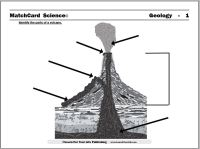Volcano Activity
This volcano activity and worksheet are used with the MatchCard Science Geology Unit Study
for 3rd to 6th grade students.
Free Download Below

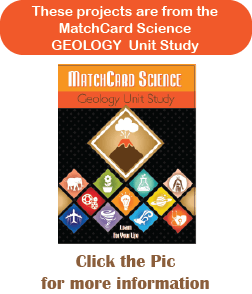
MatchCard Science Volcano
Geology MatchCard #8 Objective: Identify the parts of a volcano.How It Works: MatchCard Information Pieces are matched to the diagram on the volcano worksheet. Ideas for projects are listed on the instructor's page and below.
MatchCard Science Volcano Worksheet
This is MatchCard #8 of the Geology Unit Study. Look below for more information on MatchCards and the MatchCard Science curriculum.Volcano Activities
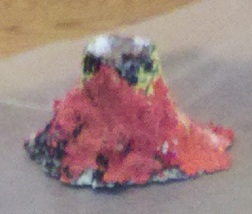
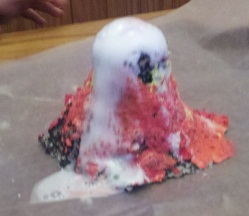
Build Your Own Volcano
Volcano building kits are available at toy stores, science stores, craft stores and just about any other store.Okay, I will admit this is more of a craft project than a science project. However, I have yet to hear of a student complaining about doing it, so it is a good activity to generate interest in the subject. (By the way, its a rare student that doesn't find volcanoes interesting anyway.)
For those of you DIYers you can also make your own volcano with papermache or clay.
For those who aren't so inclined to either build a kit or construct your own volcano, a simple (and neater) version of the project below can be completed by simpling using a small cup or baby food jar.
Let's Erupt
Once your model of the volcano (above) is completely dry, it can be erupted. Due to the obvious difficulties of creating molten rock, these "eruptions" are done simply by mixing an acid and a base and watching the chemical reaction.The usual combination is baking soda and vinegar. These are both safe and inexpensive.
Set the volcano on a table that is covered with a large sheet of paper, or an old table cloth the students are allowed to draw on.
Place one teaspoon of baking soda in the bottom of the volcano.
Pour 1/8 cup of vinegar on top of the baking soda. For added excitement, you may like to add red food coloring to the vinegar before pouring it into the volcano base.
Have the student measure how high the "ash" projects in the air.
Use a crayon to mark how far the "lava" flows from the base of the volcano.
Now repeat the steps above, using 1/4 cup of vinegar and 1/2 cup of vinegar.
Let the students discuss what would happen to the actual volcanic cone and the landscape around the volcano after multiple eruptions. Layers of lava would change the face of the volcano.
Documentary Please
National Geographic has produced a number of interesting documentaries on volcanoes, which are likely available at your local library.Volcanoes are not only an interesting part of geology, but they are a powerful and extraordinary marvel of nature when they erupt. The impact of the lives of those who live near them is intriguing and has produced fascinating stories through the ages.
Small Group Activity
With multiple students in a small group, each can be asked to present a story of a single volcanic eruption. The geograhic and geologic facts can be included as well as the impact on the lives of the community.
Please Pass the Pumice
If you can, show some pieces of pumice, which is solidified lava. The frothy lava was mixed with air, cooled quickly, and solidified with numerous air pockets like a rocky piece of swiss cheese. If you don't happen to have a piece of pumice handy, at least check out an internet picture.Let students handle it and theorize why it is light weight.
Let it float in water. What does that tell you about its density? (Answer: Less than water)
Quick Quiz: What do feet and toilets have in common?
Answer: They both are scrubbed with pumice.
No kidding, pumice blocks make a great cleaning tool to get rid of the hard ring on toilets. They are also used to remove callouses on feet. Sometimes ground up pumice can be used in such substances as toothpaste, erasers, and concrete. All of these are due to its abrasiveness.
Okay, so for those of you lucky enough to have a piece of pumice on hand, let's test it's amazing abrasive abilities. Start by marking on a brick or concrete (that you don't mind getting stained.) Mark it with:
- Chalk
- Pencil
- Crayon
- Marker
- Pen
- Lipstick or any other interesting writing tools
MatchCard Science
How To Use MatchCards

Download the FREE MatchCard Science Instructor's Guide and see how MatchCards can make building their science knowledge base fun.
Geology Unit Study
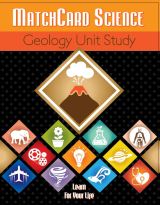
12 Science Unit Studies

Chemistry is only one of twelve complete unit studies for kids in 3rd to 8th grade.
Comprehensive objectives, hands-on projects, suggested science fair experiments, and the fun game-like MatchCards keep them interested in learning science. See all twelve MatchCard Science Unit Studies.
About Our Site
Hands-On Learning



